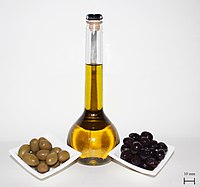
Photo from wikipedia
Abstract The effect of different concentrations of tannic acid (TA) and wheat bran (WB) for the synthesis of tannase and other hydrolytic enzymes produced by solid-state fermentation (SSF) and its… Click to show full abstract
Abstract The effect of different concentrations of tannic acid (TA) and wheat bran (WB) for the synthesis of tannase and other hydrolytic enzymes produced by solid-state fermentation (SSF) and its potential in the extraction of phenolic compounds (phenolic acids, anthocyanins and proanthocyanidins) from grape pomace (GP) were evaluated. For this, different percentages of TA (0–12%) and WB in GP (8–92%) were used. The best SSF media composition was a 1:1 ratio of WB to GP, called mixed medium (MM). In addition, the extraction from GP with the obtained enzymatic pool was compared to a commercial enzyme and a hydroethanolic extraction (HE). The results showed that the presence of TA was not significant for the production of enzymes. The extract obtained using the enzymatic pool from MM medium showed the best results for gallic acid (43.89 ± 0.26 mg.100 g-1 dried GP) and the highest α-amylase inhibitory activity (97%). These results demonstrate the possibility of the synthesis of enzymes efficient in the recovery of phenolic compounds from GP without the need for very complex supplementation during SSF.
Journal Title: Biocatalysis and Agricultural Biotechnology
Year Published: 2021
Link to full text (if available)
Share on Social Media: Sign Up to like & get
recommendations!